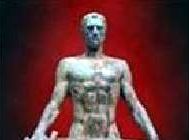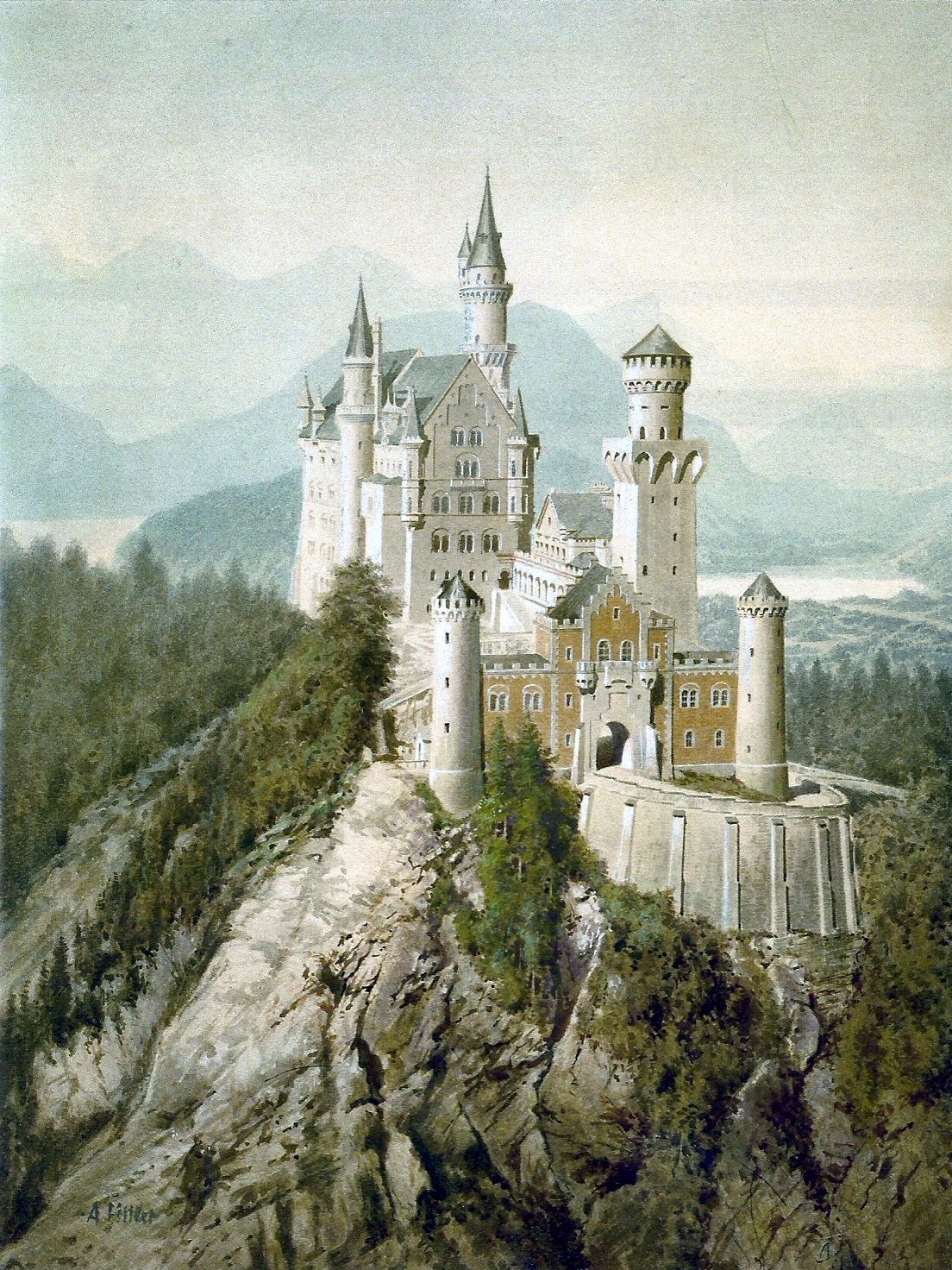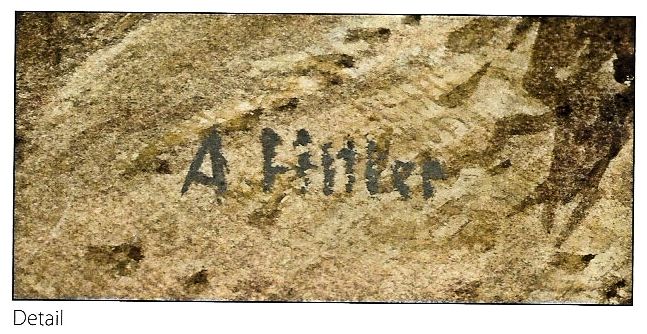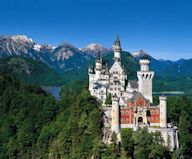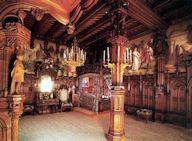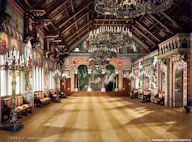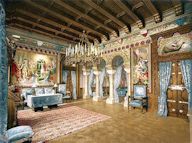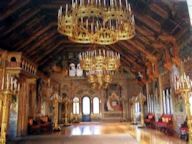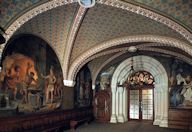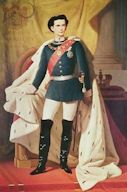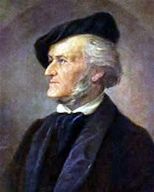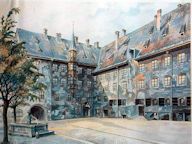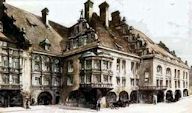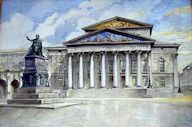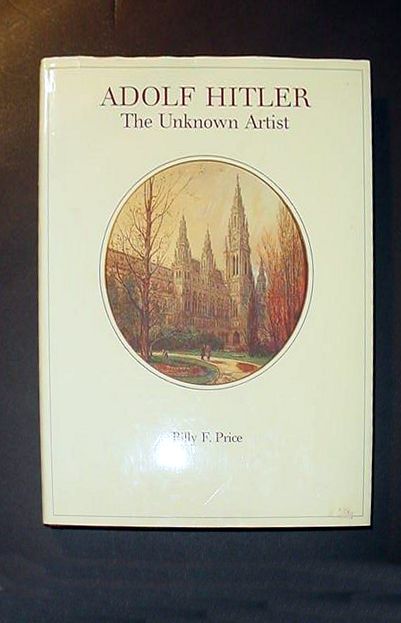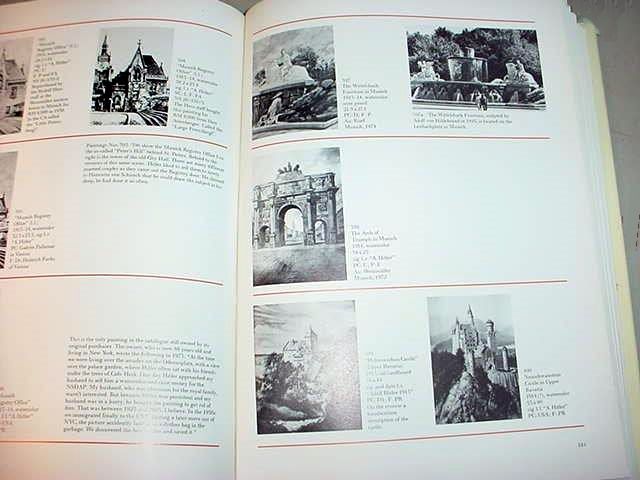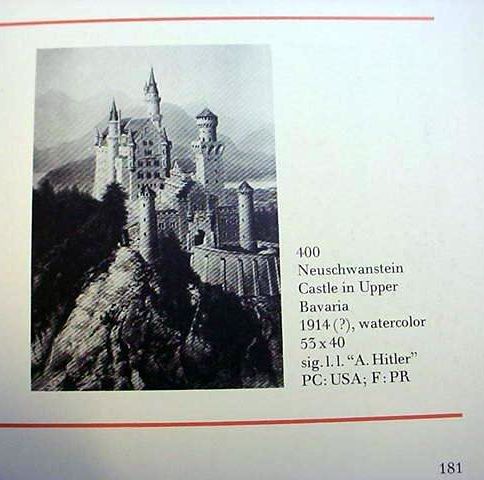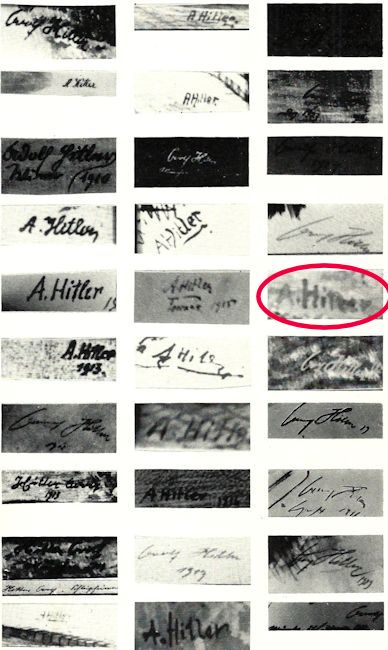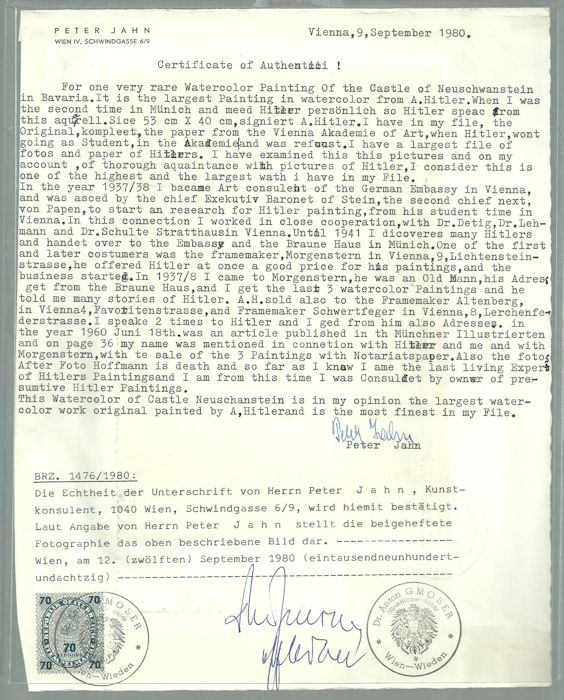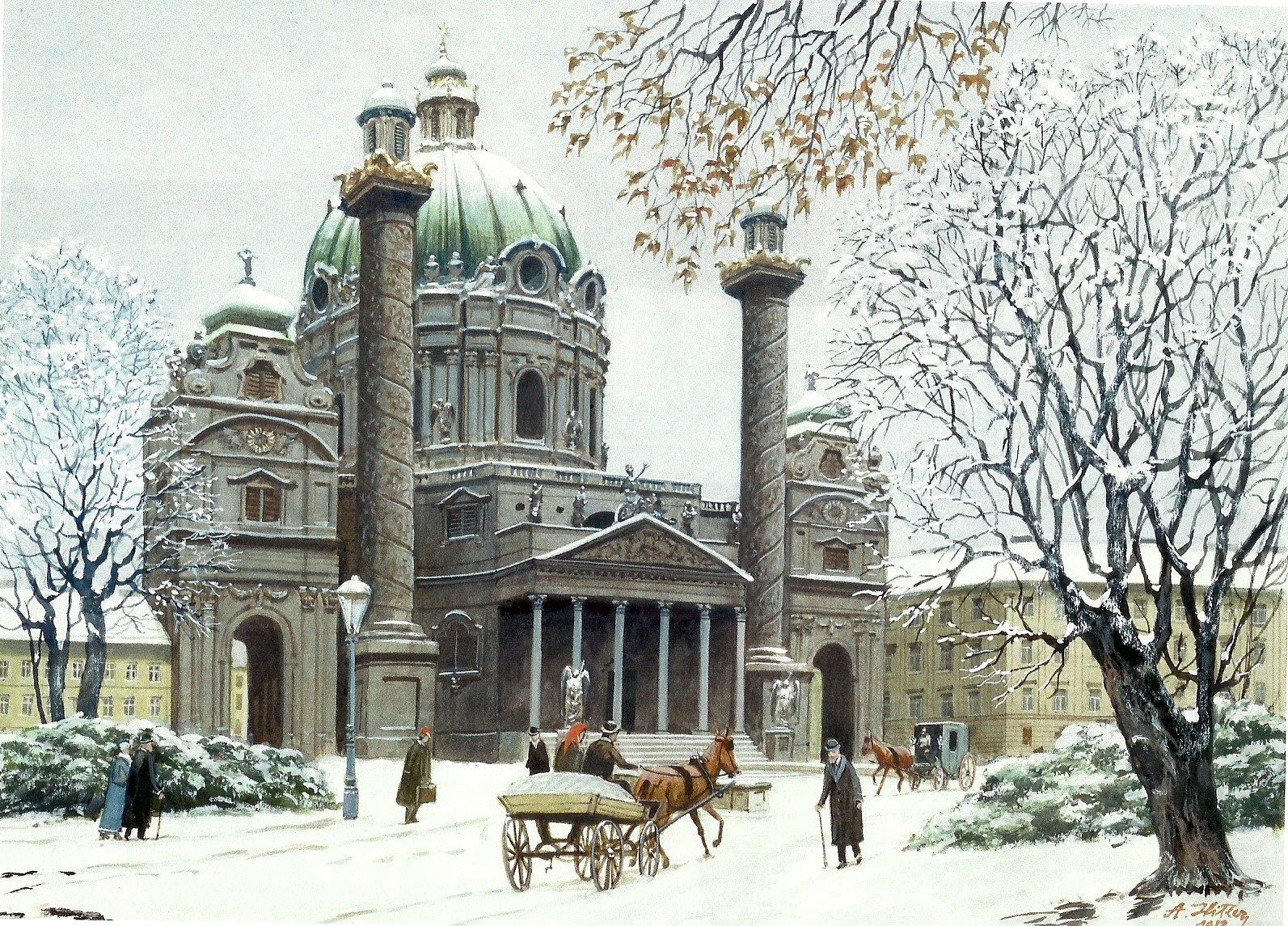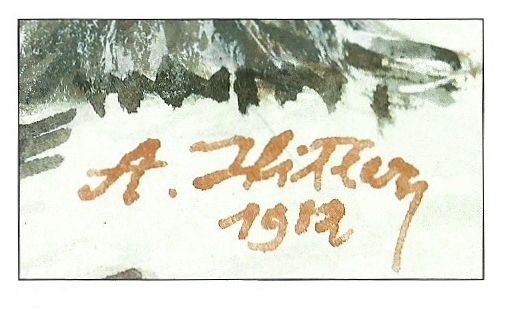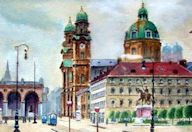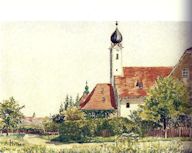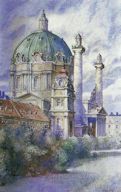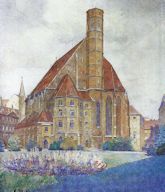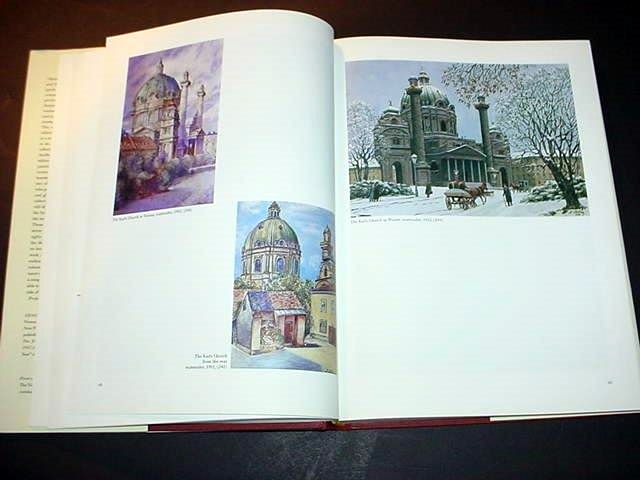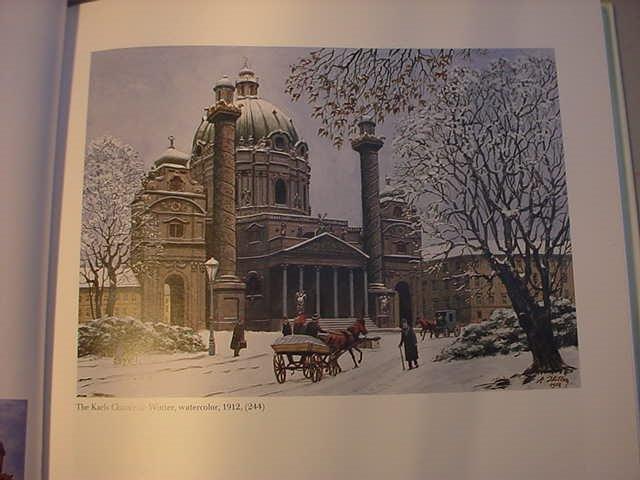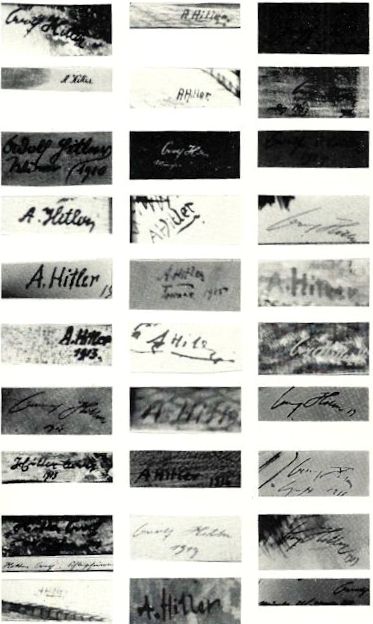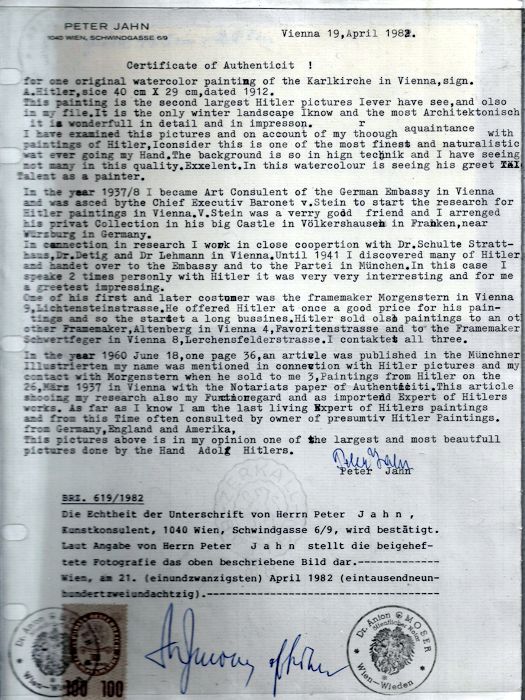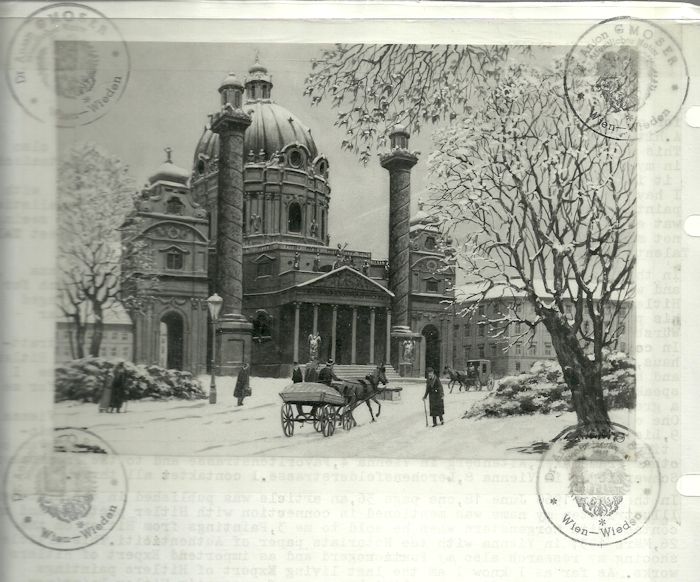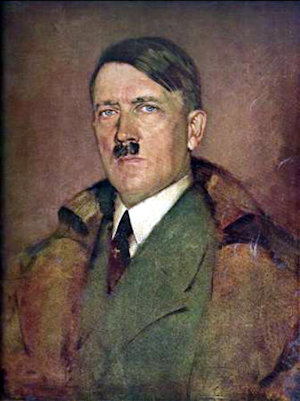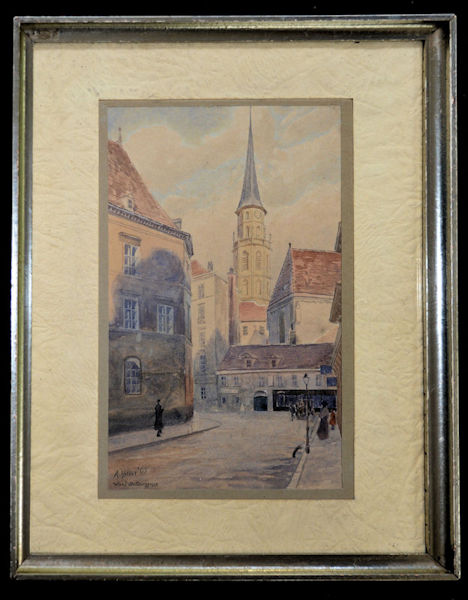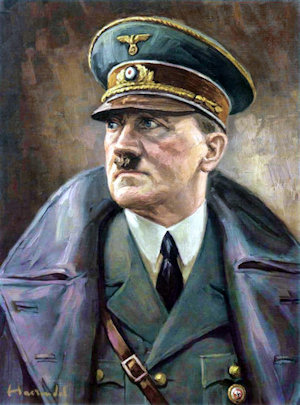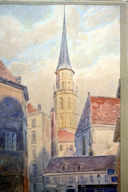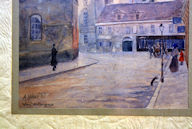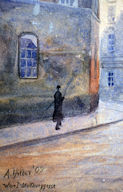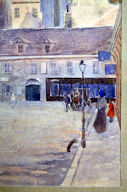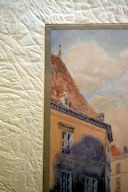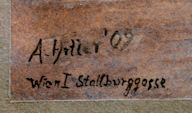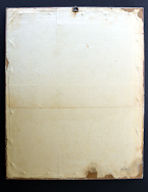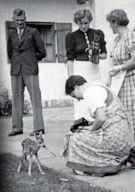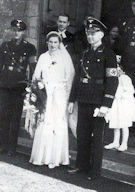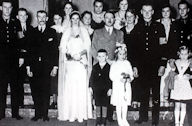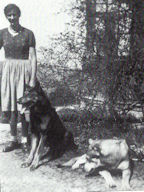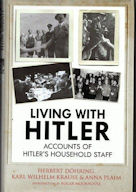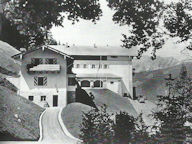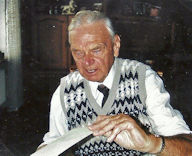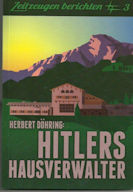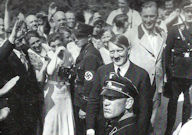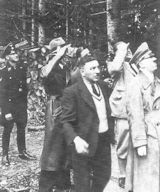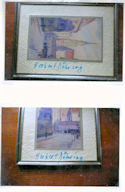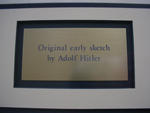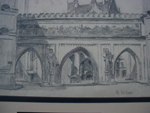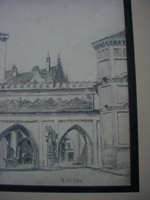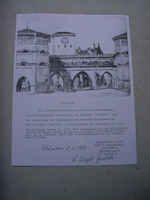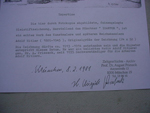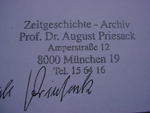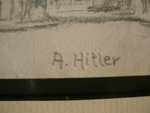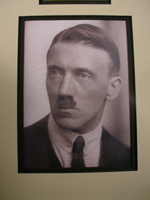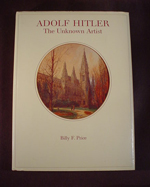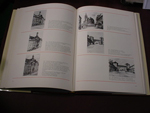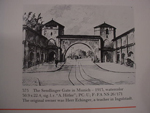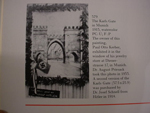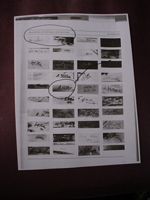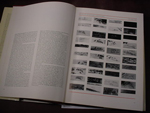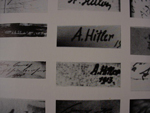|
|
|
|
|
Hitler art is the new rage among collectors BY PAUL BEDARD | OCTOBER 10, 2014 | 11:06 AM TOPICS: WASHINGTON SECRETS ART WORLD WAR II NAZIS
|
|
|
|
|
|
|
|
|
| |
Watercolor by Adolf Hitler With Strong, Official Provenance and Expertise (Item WATERCOLOR 1-1; AH 28-13; ART 17-22; SPECIAL ITEM) |
| DESCRIPTION: Recently, we were very fortunate to purchase two paintings by Adolf Hitler that are actually considered among his best. This first one shown here is an absolutely gorgeous rendering of the Castle of King Ludwig II of Bavaria—Schloss Neuschwanstein (New Swanstone Castle). This is a nineteenth-century Romanesque Revival palace. It was built by King Ludwig II as a devout homage to the great composer Richard Wagner, whom he practically worshipped. Therefore, it only follows that Adolf Hitler, who was also a devoted fan of the great Wagner would seek to honor him. It seems only logical, therefore, that New Swanstone Castle would be a natural for the young Hitler to paint at some time in his artistic career and, in my estimation, his infatuation with Wagner would have enthused him to positively strain to make this fantastic watercolor one of his finest works. The majesty of the castle as seen in Hitler’s painting is spellbinding and all who have seen it have praised it not only because it is Hitler’s work, but the painting itself emerges as a classic example of fine art of the Western world. Yes, it’s that great! Crude propagandist authors have said that Hitler was only a “house painter” before he became Germany’s leader. I am sure you have heard or seen that ignorant old canard more than once. Well, dear reader, this is one of the “houses” he painted. So just like all the other lies told about the German Führer this one needs to be trashed as well, wouldn’t you agree? We at Germania are proud as peacocks to offer this (dare I say: “masterpiece?”). “Yes, I dare!” Of all the watercolors painted by Hitler, this is one of the largest we have seen. The only full and significant literary work dealing with Hitler’s paintings is titled Adolf Hitler: The Unknown Artist by Billy F. Price, and this painting is shown on page 181 of the book and is listed as plate number 6/100. Where it is shown it says it was painted in 1914 and I think it may have been among the last renderings he produced before enlisting in the Bavarian Army and going off to war. He still found some time to paint a few Munich scenes during that period. Painting was his favorite thing in life and with high hopes, he took the examination to attend art school. To his complete disappointment, he and 85 other candidates failed the exam and were denied entrance to the prestigious Vienna Academy of Fine Arts. Today, we know that the test was stacked against the candidates; the required subjects of the exam were rather strange and the judges may have been rather prejudiced toward certain applicants from “select families.” We will never know, but when one views either of the paintings that we at Germania have procured and offer, there is not a shadow of a doubt that the young Adolf possessed a genius in architectural mastery in the arts. Just as he had opinions in the political arena and in the winning strategy in warfare (Blitzkrieg) his opinions and thoughts about art were strong and rather far beyond conservative. He believed strongly that “healthy art” had a “healthy soul.” He claimed it should be uplifting, noble, and idealistic. He considered certain themes such as the family, everyday work, mythology, rural life, and landscapes, the perfected human body, or the heroic soldier to be subjects worthy of art even though we know that depicting people was, as he admitted, not his specialty by any means. Of course, his ideas about the refinement of art seriously conflicted with the emerging schools of modern art forms, Impressionism, Cubism, Dadaism, et al. He claimed these terrible aberrations were produced by “scribblers, canvas crawlers, mental defectives, or cultural Neanderthals.” (Well put, Mein Führer!!!) Cicero said: “If we are not ashamed to think it, we should not be ashamed to say it.” So, I will say it also: “I agree with every word Hitler used in his critique of modern art.” Hitler’s architectural concepts were based upon his belief in “eternal values.” These values can be obviously perceived in his artistic works. These values contained mixed elements of classism, the renaissance, and the baroque all of which were amalgamated in the “Vienna Ring Style." This monumental expression of the 19th-century imperial power may well have been the most significant architectural feeling generated in Hitler’s youth. He was acutely impressed with so many masterpieces of the building sciences as could be seen in Vienna such as the Burgtheater, the Votive Church, city hall, and Theophil von Hansen’s great Austrian Parliament building. Hitler knew these buildings down to their finest details and painted them repeatedly. One of Hitler's favorites, which he painted several times, was Karlskirche, St. Charles’s Church, and this one also was one of the favorites of art researcher and authority Peter Jahn. This is the second Hitler canvas that we offer and is an original rendering of Karlskirche. Peter Jahn of Vienna and Dr. August Priesack were considered the leading experts able to authenticate the paintings of Adolf Hitler. In 1935, the historical section of the NSDAP official archives in Munich was assigned the systematic task of locating and certifying the paintings of Adolf Hitler. Two archivists, Wilhelm Dammann and Dr. August Priesack, worked together and were responsible for authenticating all Hitler artwork that could be traced, purchased, or borrowed. The actual search for the art was carried out by staff members under the auspices of Hitler’s deputy Rudolf Hess. One authority that I mentioned earlier was Peter Jahn. He and Dr. Priesack were the last surviving experts in the NSDAP search for Hitler’s art. Jahn had many conversations with Hitler considering art in general, but particularly the Führer’s own art. With this painting of the castle there is an official letter of authenticity from Peter Jahn regarding this watercolor in detail. Jahn recalls a conversation with the Reich’s Chancellor himself regarding this particular work, as actually being the largest surviving watercolor by Hitler. The work is in fine condition and measures 23.5 x 15.5 inches. After the war, Jahn resumed his consulting career with no thoughts of his former activities on behalf of the Hess staff. When his name was mentioned in a magazine article in 1960, however, he received inquiries from all over the world and agreed to serve as personal advisor to the English Marquis of Bath when the latter began his large, personal collection. Through his knowledge of Hitler’s Viennese style and subject matter and his numerous contacts in Vienna, Jahn has long been an authority on the subject and has traced and authenticated numerous paintings. His files and references were particularly useful to author Billy Price in writing his great hornbook on the subject Adolf Hitler: The Unknown Artist. Today, this book is one of the few works that covers the subject so thoroughly and interestingly. Both the paintings we acquired are shown in the book, but the Schloss Neuschwanstein canvas is unfortunately depicted in the noncolor section of the book; the St. Charles’s Church in winter, though, is shown in a large picture on page 49 of the price book. Hitler will forever be one of the most famous leaders in the history of mankind and the mystique and fascination surrounding him seem completely unending and if anything, he seems to be becoming more and more popular with his book Mein Kampf clocking a banner digital year in 2013 and 2014 when it became an e-book bestseller on Amazon. The Kindle version of Mein Kampf was ranking way up there on the politics and current events far outpacing books by modern day neoconservatives such as Sarah Palin, Charles Krauthammer, and Glenn Beck. So, if the book and the popularity of his artwork tell us anything beyond what is recorded in the pages of the dubious horror stories out there, it may just occur to some readers today that here was a remarkable individual and artist (a very talented artist) who turned into a “reluctant politician” and military leader whose ultimate aim was the preservation and advancement of his Fatherlands (Germany and Austria) and the creation of a “Great Art” and the preservation and protection of the Aryan culture and architecture. From time to time, we see Hitler’s artistic watercolors being offered in the $10,000 range. In fact, this is a huge underestimate and can only be applied to paintings that are probably fakes or have little or questionable provenance. Genuine Hitler watercolors with good provenance from August Priesack or Peter Jahn have sold from reputable auction house for between $50,000 and $90,000 over the past ten years with about $50 thousand to $60 thousand being brought for an average one in 2011-2013. The two we offer are far beyond average. The authors of several books by persons who sought to denigrate the Führer would invariably show his poorest paintings in their books to portray his works and the renderings as what they dubiously called a “lifeless art form.” So in essence, we are genuinely thrilled to bring forward to you these virtual masterpieces from the brush of the Führer. Not exactly lifeless, are they?! PRICE: SOLD |
|
|
|
|
|
|
| |
Here is the expertise and certificate of authenticity by Peter Jahn in reference to this watercolor by Adolf Hitler. Peter Jahn, along with Dr. August Priesack, were the only recognized authorities able to accurately authenticate Hitler paintings. Here in rather broken English Herr Jahn says unalterably that the Karlskirche in Vienna signed by Adolf Hitler and dated 1912 is authentic and he praises it as the second-largest Hitler watercolor he had ever seen and is wonderful in detail and impression. He goes on to say that he considers it to be one of the finest and most naturalistic ones he had ever personally held. He says the background displays high technical expertise and has not seen many of this high quality (Excellent!). In this watercolor one can see Hitler’s great talent as a painter. |
|
Original Adolf Hitler Watercolor of St. Charles’s Church With Official Provenance and Expertise (Item WATERCOLOR 1-2; AH 28-14; ART 17-23; SPECIAL ITEM) |
|||||||||||||||||||||
| DESCRIPTION: This is the other watercolor painted by Adolf Hitler that we recently obtained. This is the second one mentioned in the article above in the description of the canvas of the castle of Neuschwanstein. We mentioned in that narrative that there were certain buildings and other pieces of architecture that Hitler truly admired and often painted, and this magnificent depiction of Karl’s Church in Vienna was certainly his favorite subject of all. It shows up in both his sketches and paintings several times among the ones that were found. This piece we offer is a full-blown precious watercolor in all its glory. We have mentioned in the article above that only two experts have had proper credentials for authenticating Hitler watercolors and drawings. They are the late Dr. August Priesack and the late Peter Jahn and were the last surviving experts after the war to honestly authenticate a Hitler painting and such expertise from either man is the singular best authentication and support that any purported Führer art piece can carry. Others have also claimed that they can offer authentication. One such ‘expert’ that I would rather term an “X-Spurt” is Herr Hans Horvath also from Vienna. He has built for himself a completely undeserved reputation as an expert in National Socialist paraphernalia and art. In actuality he is a furniture restorer and perhaps he is good at that trade, but in the role of an authority on Hitler art, I think he had better stick to the sandpaper and glue pot. So, in essence, the singular recognized experts in this field remain the late Dr. Priesack and the late Peter Jahn: all others must be taken with skepticism.
The numerous Hitler watercolors and oils that show up are legion, and serious collectors invariably believe only in the ones that bear the Priesack or Jahn credentials. We have explained much about this in the article above regarding the magnificent Schloss Neuschwanstein watercolor. The Karlskirche in Vienna as seen in our accompanying picture just above is also like the other one—accompanied with a provenance and expertise by none other than Peter Jahn with a letter of positive authenticity dated April 19, 1982. According to Jahn, this painting, like the castle rendering, was also one of the largest Hitler watercolors he’d ever seen. The size is 15.75 x 11.5 inches. This is absolutely in my opinion as well, one of the most detailed and crisp examples of Hitler’s work ever located and offered. It is definitely done with watercolor and gouache, boldly signed and dated “1912.” It is in fine condition throughout. The great architectural technique is superb and the people in the depiction are somewhat substantial. Hitler, jokingly perhaps, often said that his paintings could easily be recognized by their “unreal people;” however, the incredible attention to detail in his landscapes, city scenes, and architectural renderings absolutely abound in realism while unfortunately less apparent in his handling of the human figure. It is obvious in his works that he reached for majesty in some of his art, but he also pictured simple Germanic country scenes, as well. For him, the great structures such as the Pergamon Altar and the Parthenon, both of ancient Greece, and the ancient Roman Pantheon, symbolized for him the dimension and glory of the race he considered the founders and builders of Western civilization—the Aryans. The monumental cathedral constructions of the medieval period, the palaces of the Renaissance and the neoclassical structures of the 19th century were as he often said, “expressions of a cultural community, a heritage to be preserved and perpetuated.” Why did Hitler the purported atheist paint churches and cathedrals? Why indeed? Well first of all, the dubious atheist contention comes from the writings and verbal utterings of the “court historians” who seek always to slander him to the fullest with pompous insolence bordering on superciliousness. They seem duty bound with their chosen agenda to attack every vestige of the man’s very being. Hitler was certainly no atheist. He was raised a Catholic and never at any time renounced his faith. In his book Mein Kampf he proclaimed his Christianity and in numerous verbal pronouncements he spoke of his belief in an “Almighty Creator.” Yes, to some extent, he harbored the anticlerical belief that the church in Rome wielded too much power over its faithful adherents; he disdained “churchology” believing God lives within the soul of man and determines his destiny. He was always in favor of “positive Christianity.” He said in a 1922 speech, “My feelings as a Christian point me to my Lord and Savior as a ‘Kämpfer [“fighter”].” In a 1928 speech he said, “We tolerate no one within our ranks who attacks the idea of Christianity . . . in fact our movement is Christian!” So perhaps this is why he so often portrayed the glory and majesty of churches, abbies, and cathedrals in his paintings both in Germany and Austria. The Karl’s Church in Vienna was, as we said, one of his favorite-subject paintings not only because of its beautiful architectural value, but probably because his youth was spent in the study and admiration of famed saints of the church—as any good altar boy would be proud to do. His appreciation of Saint Charles Borromeo, the Patron of the Baroque, was one of the greatest reformers of the 16th century. In 1713, one year after the last great plague epidemic, Charles VI, Holy Roman Emperor, pledged to build a church for his namesake patron Saint Charles Borromeo, whom was revered as a healer for plague sufferers. Mr. Billy Price’s book Adolf Hitler: The Unknown Artist depicts numerous churches that were painted by Adolf Hitler. It seems it was his most preferred subject matter and obviously, this says something at least about his very nature and his spirituality. He actually portrayed Karl’s Church in many different views—front, back, sides—over a period of time and he found during his Vienna period of painting that the depictions of this building sold by far the best to the public whom he at that time desperately sought to sell to. But as to the several churches that he artfully depicted, we know this one by far is the absolute finest! Its brilliance and clarity stand out like a beacon shedding the true artistic light that now goes far to illuminate the intense interest that the future Führer had in all things religious when he was young. It now looms obvious and can be plainly seen in this magnificent watercolor that this must be called a “very significant work” and we know it was painted by this amazing artist whom the autochthonous plebian writers call a “house painter” in their ever-dubious inflammatory writings. So, here is what I would dare to call a “masterpiece” with ironclad provenance and expertise by one of the only two authorities recognized in the art circles for Hitler paintings. This is a golden opportunity to make a very wise purchase that can only increase in value in a very short time. Already, a watercolor painted by Hitler was reported to bring almost $15,000 in an auction on or about April 23, 2009. But, this painting was in my estimation very dismal and dark and reportedly had no letters or documents of authentication or any provenance. Actually, I didn’t even think it was Hitler’s style at all! This story is repeated over and over every year that goes by. The mere mention of anything that Adolf Hitler owned or produced seems to appeal to those who for any reason are so fascinated with him as to loosen their pockets in a heartbeat if the chance to buy something no matter how loose the connection is or how much actual authentication is provided (Barnum was obviously right!). This dubious canvas that brought nearly the $15,000 was sold in England by Mullock's Specialist Auctioneers & Valuers in Shropshire. So I repeat again that only the expertise of Dr. Priesack and/or Peter Jahn is accepted today, Otherwise you “pays your penny and takes your chance.” In closing let it be said that if you ever wanted to own the ultimate Hitler item actually produced by this phenomenal man here is the unique opportunity that will be before you in all probability only once!
PRICE: SOLD |
|
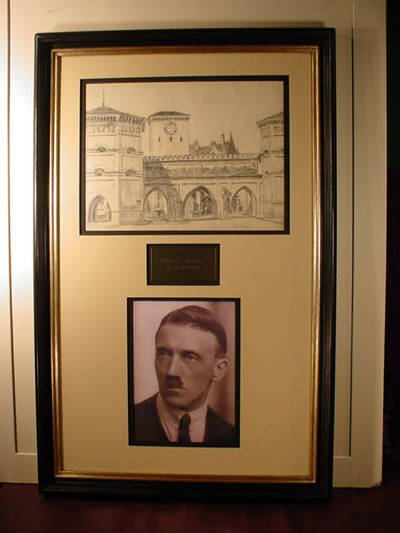 The Framed Sketch |
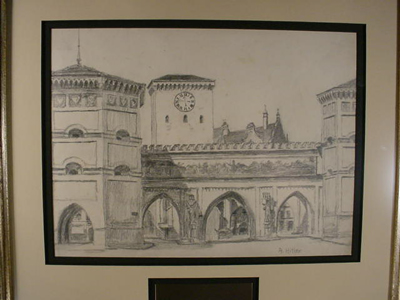 |
Original Early Sketch by Adolf Hitler Accompanied With Official Provenance (Item WATERCOLOR 1-4; AH 26-22 & ART 17-7) |
DESCRIPTION: Here is an incredible find. A great sketch rendered by Adolf Hitler just before WW I. The sketch is of the famed Munich Isator (the old city gate that dates from the 14th century. As fate would have it the famous Beer Hall Putsch of Nov 9th, 1923 proceeded through the Isator. You can see Hitler and his followers passing through it on that fateful day. See it on a site named Hitler pages München.) There were four gates that were entrance points of the old walled city. The Karl’s Gate, the Sendlingern gate, the Schwabingertor and the Isator. Only the Schwabingertor is no longer there (demolished at the beginning of the 19th century). The famous Feldherrenhalle stands at that site today. In 1984 Billy V. Price of Texas published a book on Adolf Hitler’s art titled ‘Adolf Hitler the Unknown Artist.’ In this beautiful edition he shows many Hitler oils, watercolors and sketches done by Germany’s future Fuhrer in his early years. It is interesting to note that Hitler was somehow inspired by these Munich gates and often portrayed them in his art renderings. In Price's book there are several depictions in sketches of the Sendlinger Tor, and the Karlstor but none of the Isator. Now it only stands to reason that he would have sketched the three gates that still existed in his time. When one observes the watercolor of the Sendlinger Tor on page 175, at the bottom of the page you can sense the identical style as seen in the sketch we offer here. We believe we have turned up the missing gate by A. Hitler. So here we proudly present the Isortor and with this rendering is an official provenance dated August 2, 1981 by Professor August Priesack. This man and one Herr Peter Jahn of Vienna (both deceased) were the only reliable persons who were known and trusted researchers of Hitler paintings and sketches. Herr Jahn was a noted authority of Hitler’s art and actually was employed by Reichskanzler Hitler when in 1935 a systematic search for Hitler’s art was given an official status by the historical research division of the NSDAP central archival authority. Jahn was given the task of recovering Hitler’s works of art. This so-called ‘secret section’ was exclusively involved in researching Hitler’s past. Two archivists Wilhelm Dammn and Dr. Professor August Priesack worked together and were responsible for authenticating all Hitler art that could be purchased or borrowed. The actual search for the artworks was carried out by the staff members under the departmental jurisdiction of Hitler’s deputy, Rudolf Hess. When a painting or drawing was located, the staff’s cultural attaché Dr. Ernst Schulte-Strathaus turned over the work to Herr Dammann and Dr.Professor Priesack for thorough examination. Two years after the Munich team of Dammann and Priesack had begun its work the Chief Officer of the German Embassy in Vienna Baron Otto Von Stein contracted the Viennese art historian and dealer Peter Jahn at the behest of Adolf Hitler and the NSDAP and requested his help in locating those of the Führer's works done in Austria. Herr Jahn took the assignment and on two occasions personally delivered paintings to the NSDAP headquarters in Munich where he met Hitler and discussed art and Hitler’s early experiences in Vienna. Before his death Dr. Priesack had accomplished significant research in the field and possessed the largest collection of documentation on Hitler’s art in the world. With Peter Jahn these two men were considered the last surviving experts on the authentication of Adolf Hitler’s art. Without the accompaniment of provenance of either of these two historians and researchers one can never be quite sure of the authenticity of Hitler’s paintings or sketches. We are proud of this marvelous acquisition with Dr. Priesack's signed statement accompanying it. The Isator sketch is measured at 24 x 32 and the respected professor basically says: (Expertise) “Seen above are photos and details of this remarkable and finely executed pencil drawing of the stable-end of the Munich Isartor and is a genuine work of the artist Adolf Hitler (1889-1945) the original size is 24 x 32 (cm). This rendering was originated circa 1913-1914 and produced when his signature corresponds within this date. This was a favorite motif of Adolf Hitler. Offered by Dr. A. Priesack since 1935 specialist of or the works of Adolf Hitler (Munich 8.2.1981)." Dr. Priesack's archive stamp also appears with his former office address, and it of course signed in hand by the professor. The Hitler signature is just as the Herr Professor has indicated, correct for that early time in Hitler’s life. The sketch is nicely framed and matted on a special hand-made frame measuring 18 ½ by 29 ½ inches. The actual drawing is about 12 inches by 10 inches mounted and matted. Within the frame is a 6 ½ x 8 ½ copy of an early picture of the young Hitler. The drawing is museum mounted (not glued) inside the frame and the glass is of special non-glare construction that makes the glass virtually invisible with UV filtering. The matting is expertly done with expensive craft paper and the sketch is deeply set to avoid contact with the glass. Spacers were utilized. The result is that the artwork looks to be floating in the frame. This is the most desirable method when framing an important art work such as this. The framing of this sketch was done with absolute mastery of the framing art. A copy of the Preisack letter is in a pocket on the back of the frame but the original letter goes with the purchase of course. Here is a rare chance to own an authentic drawing by the 20th century’s most famous world leader. A man whose watercolors are highly sought after and bring “astronomical prices” while the renderings of Winston Churchill (who fancied himself an artist and ‘Ike’ Eisenhower’s paintings bring very little on the art market) but before anyone jumps to the conclusion that it is only the morbid collector who would collect Hitler’s paintings and drawings because of his so-called “evil image”-(debatable!) Think about war criminal Churchill’s orders resulting in the genocide perpetrated against the thousands of innocent people of Dresden and “Ike’s outright heinous genocidal order murdering nearly a million German POWs in the prisoner of war camps along the Rhine in 1945. (Please read David Irving’s “Destruction of Dresden” and James Bacque’s, “Other Losses” available from Amazon books on the internet). Adolf Hitler was in fact a darned good artist while Winnie and Ike were less than mediocre as painters. PRICE: $15,000.00. This is a great investment for the price of this leader’s special art that will continue to elevate in value quickly in a very short time |
Contact Us
Please E-mail for any additional information you may need.
If you prefer, contact 'Germania' at PO Box 68, Lakemont, GA 30552
or call at 706.782.1668.
Please! do not call during the wee hours of the morning. The best time for calling us is between 10 am and 12 noon and between 9 and 11 pm eastern time.


